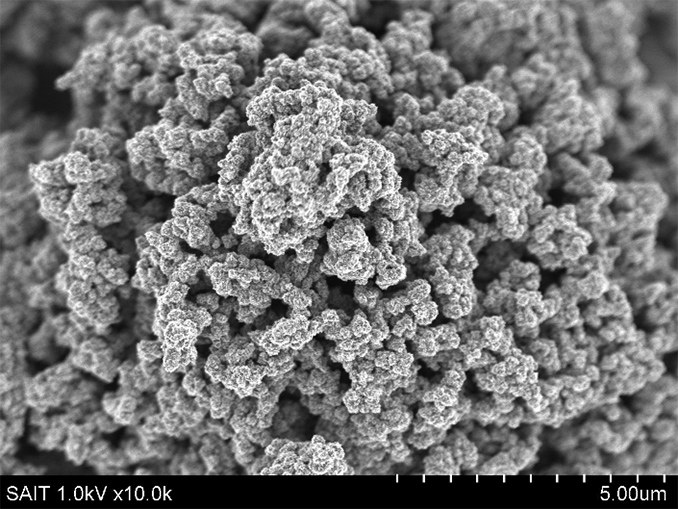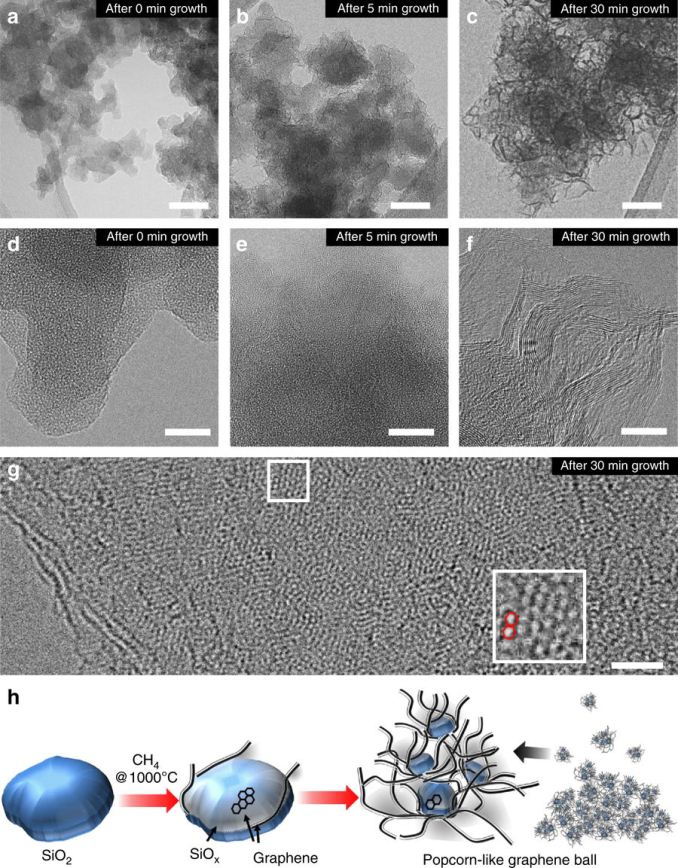Samsung’s Reveals Li-Ion Battery with Graphene Balls: Higher Capacity, Faster Charging
by Anton Shilov on November 29, 2017 5:00 PM EST- Posted in
- Mobile
- Samsung
- Battery
- Samsung SDI
- Graphene

Samsung on Tuesday announced that it had developed a way to improve Lithium-Ion batteries with its new material called graphene balls. The company says that batteries featuring the new material charge five times faster than conventional Lithium-ion accumulators and enable a considerably higher volumetric energy density.
The new battery technology developed by Samsung SDI and its partners* uses the so-called graphene balls (a 3D structure synthesized from silicon dioxide, Si02) to cover a cathode and also as an anode material. Graphene balls on the cathode suppress damaging side reactions while also providing efficient conductive pathways. This enables faster charging (as graphene features 140 times faster electron mobility than silicon) and increases the number of cycles a cell can withstand. According to Samsung, a battery cell featuring graphene balls has a 27.6% higher volumetric energy density compared to a similar cell without graphene balls. Furthermore, the cell also retains 78.6% of its capacity after 500 cycles at between 5°C and 60°C.
Samsung articulates that graphene balls could enable batteries with up to 45% higher capacities (than contemporary batteries) that can charge in 12 minutes – or five times faster than today’s batteries, as Samsung puts it. However, what Samsung is not saying when it intends to use the technology for commercial applications. Incorporation of a new protective layer for cathode and switching anode material changes battery production technology, which generally affects costs. Meanwhile, Samsung claims that the graphene ball material is not expensive to produce using its new chemical vapor deposition (CVD) process. To grow graphene around SiO2 nanoparticles with diameters of 20–30 nm, Samsung feeds them into a furnace and feds methane (CH4) into it at 1000°C.
“Our research enables mass synthesis of multifunctional composite material graphene at an affordable price,” said Dr. Son In-hyuk, who led the project on behalf of SAIT*. “At the same time, we were able to considerably enhance the capabilities of lithium-ion batteries in an environment where the markets for mobile devices and electric vehicles is growing rapidly. Our commitment is to continuously explore and develop secondary battery technology in light of these trends.”
Samsung expects to use its Li-ion batteries featuring graphene balls for electric vehicles and various mobile devices. Since the improved batteries can handle temperatures of around 60°C, they are a good fit for both applications. The most important question is of course when exactly Samsung SDI plans to commercialize them. To that end, it is noteworthy that earlier this year an unnamed executive from Samsung SDI told a newspaper that the company would be able to produce solid-state batteries for smartphones sometimes in 2019.
*The new battery technology was co-developed by Samsung SDI (the company’s battery arm), Samsung Advanced Institute of Technology (SAIT) as well as Seoul National University’s School of Chemical and Biological Engineering.
Related Reading:











45 Comments
View All Comments
Ian Cutress - Thursday, November 30, 2017 - link
Fast charging creates longer reach crystal growth between anode and cathode, causing shorter distance separation and shorts. When you can't intercalate your ions in the most dense way due to speed, it leaves solid-state holes (or even clogs them) which leads to lower capacity.MrSpadge - Thursday, November 30, 2017 - link
Yes, that spec is just average. Howerver, it's obtained at very high charging rates and probably while allowing elevated temperatures. If you back off these requirements (as your comparison points do), the number of charge cycles will likely increase. I think they've chosen these specs to show that they can attain a cycle time useful for real world usage while still providing significant benefits in other parameters.MrSpadge - Thursday, November 30, 2017 - link
BTW: Fig. 5e from the paper shows a comparison with a regular cell at high charging currents ("5C") and 60°C. The cell is completely broken after ~20 cycles.melgross - Thursday, November 30, 2017 - link
This is the same problem we’ve been seeing, for years, with the lithium II cells promised several years ago, but never produced. They show tremendous capacity in demo’s, but they deteriorate rapidly upon charging. They just have a handful of charges before they drop to useless levels.Speedfriend - Thursday, November 30, 2017 - link
These are aimed at electric vehicles where recharge speed is more important than whether the battery degrades 10% or 20% over 500 full recharge cycle, which for most users would be over 10 years of driving.1prophet - Wednesday, November 29, 2017 - link
“My top advice really for anyone who says they’ve got some breakthrough battery technology is please send us a sample cell, okay. Don’t send us PowerPoint, okay, just send us one cell that works with all appropriate caveats, that would be great. That sorts out the nonsense and the claims that aren’t actually true.” Elon MuskIan Cutress - Thursday, November 30, 2017 - link
Good words. There's some awesome battery tech out there. One example is a sulphur battery, with better energy density and recyclability than Li-Ion. The downside? It needs to operate at 300ºC. Or how about that Aluminium battery that is a lot safer and potentially cheaper? Sorry, only 1/3 of the energy density.Hurr Durr - Thursday, November 30, 2017 - link
Quite ironic, considering his own promise trail.MrSpadge - Thursday, November 30, 2017 - link
"This enables faster charging (as graphene features 140 times faster electron mobility than silicon)"Anton, this way added by you, wasn't it? I suspect this is completely wrong due to several reasons:
- ions have far lower mobility than electrons inside conductors, so these should rather limit the current
- I don't think Si is used at all in Li-Ion batteries
- graphene has widely varying mobility, depending on the fermi level, surface chemistry and defects
- the conductivity is mobility times number of charge carriers. The latter is small in graphene, because as a 2D material there's just not much of it. So it's conductivity is not as high as the (potentially) high mobility suggests. What limits the batteries is internal resistivity, i.e. 1/conductivity of the worst path
MrSpadge - Thursday, November 30, 2017 - link
BTW: it would have been nice to include the figure captions, as it's not obvious what we're seeing especially in the 2nd figure.